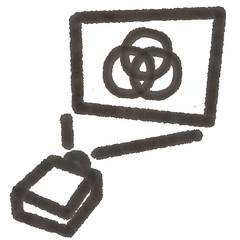The overall question is: what can be presented orally? Be aware that some types of content are better suited for reading. Having said this, let’s turn to more concrete rules of thumb. First, I will treat some technical issues and then I will turn to more “behavioural” aspects of a presentation.
Be moderate!
Strictly avoid fancy colours or too many colours! Your slides might look nice on your own computer but in a lit up room your audience will not be able to read your slides. In my view a white background with an “ordinary” typeface is the safest even though it is not the most exciting way to present. However, it will emphasize your message and not your (allegedly) artistic ambitions. It also goes without saying that normally you should stay away from excessive use of fancy transitions and strange sounds. I say normally because from time to time something unexpected might wake up an audience who is about to fall asleep.
Be choosy!
Don’t try to cram your entire paper or report into your slides. In most cases lots of text will interfere with your speech; the audience will keep trying to read from your slides while you are talking about something else and the messages of both modes will be lost. If you cannot avoid several lines of text, give at least your audience a chance to read it while you keep quiet or, better, read the text for your audience. Since you put all that text in your slide it must considered very important. Accordingly, read it for them or give them a chance to read!
Arrest them!
Now let’s turn to the “behavioural” aspects of your speech. First of all: don’t overestimate your audience, especially not after lunch or late in the afternoon. Initially you must arrest your audience’s attention You may do this through a relevant video clip, audio recording, music, or a good story etc. Use judiciously!
Use some energy when you present but don’t overdo it so that your audience becomes quite exhausted after your presentation. Since it is an honour to have an attentive audience, you must show them that your are really pleased to be there having the opportunity to talk about something that matters to you. It goes without saying that the bored presenter deserves a bored and inattentive audience.
Speak up! Some people in your audience do not hear well. It is particularly important that you speak up when your speech is in a foreign language.
Guide them!
Introduce your topic, problem, or issue. You cannot rely on your audience to discern what is important. Tell them what is interesting, what they should notice. Depending on your audience, take pains to explicate your topic in as everyday language as possible. Try to summarize what your are going to say in a few effective points (normally no more than what you can imagine your audience will be able to keep in mind, roughly three)
Adjust!
If you must read from your manuscript, slow down the speed! Remember that oral and written language are different languages. Oral language is direct with lots of co-ordinating conjunctions (and, but, or etc.) whereas written language can be much more complex with main and subordinate clauses. Normally it is a problem to speak written language. If you after all have to read from your manuscript, don’t speak incessantly. Be quiet from time to time! Vary your voice!
Hook them!
Concerning the architecture of your speech we have already said something about the start where you build rapport and introduce your topic; you give your audience a kind of road map. But what then?
During the body of your presentation you should give your audience “hooks” for their attention. At the best your audience will recognize your hooks from your introduction and they will give nods of recognition. If they do not, help them by “showing” the map again through gently repeating the path of your speech.
It might also be a good idea to present cases or situations where you start from some problematic situation and eventually end up with a solution. This introduces a kind of drama or narrative in your presentation thus arresting the audience's attention like any good story, film or novel will do. Carefully selected examples from "real life" can be very helpful when your audience is about to fall asleep. Remember that a presentation is kind of performance!
Persuade them!
To make sure that your audience really notices your points you can (or should) meta comment your speech to help them follow your presentation but also to make sure they understand your presentation the way you want it to be understood. Simply tell them what you are going to say or how to understand: Now I will turn to …, The first thing I noticed …, The result means …
Summarize!
When you end your speech, it is important that you end your presentation smartly. Nobody likes to lose one’s way. Therefore you should tell them where they have been i.e. tell they what you have argued for by referring back to your introduction.
Improve!
The Net is an unfailing soruce for anyone who wants to improve presentation skills. Entering “presentation” “oral presentation” or similar words in search engines like Google, YouTube, SlideShare will give lots of valuable tutorials. Some examples:
Ten Simple Rules for Good Presentations
Killer Presentation Skills
Presenting with Text
Death-by-PowerPoint
… and many, many more.

This work is licensed under a Creative Commons Attribution-NonCommercial-ShareAlike 3.0 Unported License





Inga kommentarer:
Skicka en kommentar